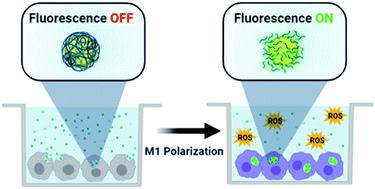当前位置:
X-MOL 学术
›
Nanoscale Adv.
›
论文详情
Our official English website, www.x-mol.net, welcomes your feedback! (Note: you will need to create a separate account there.)
Poly-D-lysine coated nanoparticles to identify pro-inflammatory macrophages
Nanoscale Advances ( IF 4.7 ) Pub Date : 2020-07-13 , DOI: 10.1039/d0na00373e Derek S Hernandez 1 , Hattie C Schunk 1, 2 , Karan M Shankar 1 , Adrianne M Rosales 2 , Laura J Suggs 1
Nanoscale Advances ( IF 4.7 ) Pub Date : 2020-07-13 , DOI: 10.1039/d0na00373e Derek S Hernandez 1 , Hattie C Schunk 1, 2 , Karan M Shankar 1 , Adrianne M Rosales 2 , Laura J Suggs 1
Affiliation

|
Identifying pro-inflammatory macrophages (M1) is of immense importance to diagnose, monitor, and treat various pathologies. In addition, adoptive cell therapies, where harvested cells are isolated, modified to express an M1-like phenotype, then re-implanted to the patient, are also becoming more prevalent to treat diseases such as cancer. In a step toward identifying, labeling, and monitoring macrophage phenotype for adoptive cell therapies, we developed a reactive oxygen species (ROS)-sensitive, gold nanoparticle (AuNP) that fluorescently labels M1 macrophages. AuNPs are electrostatically coated with a proteolysis resistant, fluorescein isothiocyanate-conjugated, poly-D-lysine (PDL-FITC) that is susceptible to backbone cleavage by ROS. When PDL-FITC is bound to AuNPs, fluorescence is quenched via a combination of nanoparticle surface (NSET) and Forster resonance (FRET) energy transfer mechanisms. Upon ROS-induced cleavage of PDL-FITC, up to a 7-fold change in fluorescence is demonstrated. PDL-FITC AuNPs were loaded into RAW 264.7 macrophages (RAWs) and primary bone marrow- derived macrophages (BMDMs) prior to in vitro polarization. For both cell types, detectable differences in intracellular fluorescence were observed between M1 polarized and non-stimulated (M0) control groups after 24 h using both confocal imaging and flow cytometry. PDL-FITC AuNPs can potentially be useful in identifying M1 macrophages within diverse cell populations and provide longitudinal macrophage response data to external cues.
中文翻译:

用于识别促炎巨噬细胞的聚-D-赖氨酸涂层纳米颗粒
识别促炎巨噬细胞 (M1) 对于诊断、监测和治疗各种病理非常重要。此外,过继细胞疗法(其中收获的细胞被分离、修饰以表达 M1 样表型,然后重新植入患者体内)在治疗癌症等疾病方面也变得越来越普遍。在为过继细胞疗法识别、标记和监测巨噬细胞表型的一步中,我们开发了一种对活性氧 (ROS) 敏感的金纳米颗粒 (AuNP),它可以荧光标记 M1 巨噬细胞。AuNPs 表面涂有抗蛋白水解的异硫氰酸荧光素共轭聚-D-赖氨酸 (PDL-FITC),易受 ROS 主链裂解的影响。当 PDL-FITC 与 AuNPs 结合时,荧光通过纳米粒子表面(NSET)和福斯特共振(FRET)能量转移机制的结合。在 ROS 诱导的 PDL-FITC 裂解后,显示出高达 7 倍的荧光变化。在体外极化之前,PDL-FITC AuNPs 被加载到 RAW 264.7 巨噬细胞 (RAWs) 和原代骨髓衍生巨噬细胞 (BMDMs)中。对于这两种细胞类型,使用共聚焦成像和流式细胞术在 24 小时后观察到 M1 极化和非刺激 (M0) 对照组之间可检测到的细胞内荧光差异。PDL-FITC AuNPs 可能有助于识别不同细胞群中的 M1 巨噬细胞,并为外部线索提供纵向巨噬细胞反应数据。
更新日期:2020-09-16
中文翻译:

用于识别促炎巨噬细胞的聚-D-赖氨酸涂层纳米颗粒
识别促炎巨噬细胞 (M1) 对于诊断、监测和治疗各种病理非常重要。此外,过继细胞疗法(其中收获的细胞被分离、修饰以表达 M1 样表型,然后重新植入患者体内)在治疗癌症等疾病方面也变得越来越普遍。在为过继细胞疗法识别、标记和监测巨噬细胞表型的一步中,我们开发了一种对活性氧 (ROS) 敏感的金纳米颗粒 (AuNP),它可以荧光标记 M1 巨噬细胞。AuNPs 表面涂有抗蛋白水解的异硫氰酸荧光素共轭聚-D-赖氨酸 (PDL-FITC),易受 ROS 主链裂解的影响。当 PDL-FITC 与 AuNPs 结合时,荧光通过纳米粒子表面(NSET)和福斯特共振(FRET)能量转移机制的结合。在 ROS 诱导的 PDL-FITC 裂解后,显示出高达 7 倍的荧光变化。在体外极化之前,PDL-FITC AuNPs 被加载到 RAW 264.7 巨噬细胞 (RAWs) 和原代骨髓衍生巨噬细胞 (BMDMs)中。对于这两种细胞类型,使用共聚焦成像和流式细胞术在 24 小时后观察到 M1 极化和非刺激 (M0) 对照组之间可检测到的细胞内荧光差异。PDL-FITC AuNPs 可能有助于识别不同细胞群中的 M1 巨噬细胞,并为外部线索提供纵向巨噬细胞反应数据。


























 京公网安备 11010802027423号
京公网安备 11010802027423号